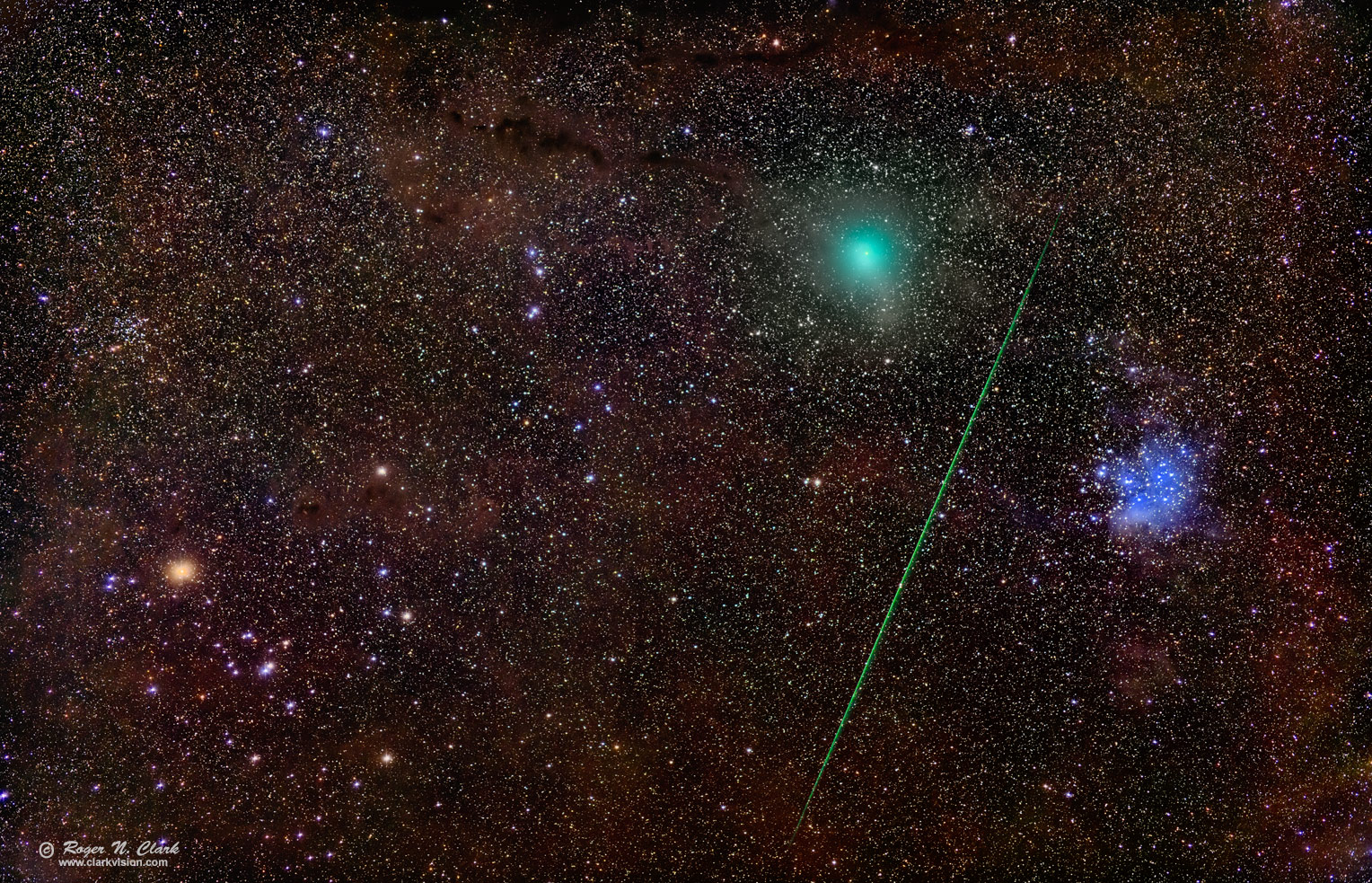| Home | Galleries | Articles | Reviews | Best Gear | New | About | Contact | Gallery Index | Previous |
Next |

| Home | Galleries | Articles | Reviews | Best Gear | New | About | Contact | Gallery Index | Previous |
Next |

Comet 46/P Wirtanen made an unusually close pass by the Earth in mid-December, 2018. The scene here shows the comet as it just passed the Pleiades, M45 (the star cluster on the right embedded in blue reflection nebulosity from dust). The comet appeared about double the size of the Pleiades. The faint outer portions of the comet's coma combines with light from the reddish background interstellar dust making an olive-drab color. The blue-green color of the comet is due primarily to emission from carbon. The green color of the meteor is due to emission from ionized magnesium. The air in our atmosphere is also ionized by the meteor, but the emissions of nitrogen and oxygen are in the red and infrared and not dominant in this meteor trail. The meteor was a sporadic and not associated with any meteor shower.
The Hyades are the bright stars on the left and the brightest star is orange Aldebaran, Alpha Taurus. Above the Hyades is the small Pirate Moon Cluster, NGC 1647. The stars in NGC 1647 appear white because they are close to solar type stars (only about 10% bluer).
This is a very colorful region of the sky, blue reflection nebulae in the Pleiades, star clusters (Hyades, Pleiades and more), orange interstellar dust and colorful stars--hot blue-white stars to cool orange and red stars. This image was made with a stock digital camera and processed to bring out the wonderful colors in the region.
Technical. This image was obtained with a Canon EOS 6D Mark II DSLR Camera and Sigma 105mm f/1.4 DG HSM Art Lens at f/1.4 and ISO 1600, 30 second exposures and 116 exposures stacked for a total of 58 minutes exposure time. No dark frame subtraction, no flat fields. Tracking with a Fornax Lightrack II and no guiding. The full resolution image plate scale is 11.2 arc-seconds per pixel and the image here is at 1/4 resolution.
Post processing: Raw conversion with Rawtherapee with settings tuned for astrophotos, including maintaining star color in saturated stars. Rawtherapee processing settings described here. Output color space was Rec.2020 to match the future of high dynamic range TVs. Look for a future article on this topic. Stretched with rnc-color-stretch. Also see Astrophotography Image Processing Basic Work Flow.
This is a natural color image. The high dynamic range of astrophotos must be stretched to bring out the range of details the camera recorded. But the typical image stretch process loses color for brighter subjects (e.g. stars and the brighter parts of deep sky objects become whiter as they are made brighter). This image uses an algorithm that does not lose color during the stretch. The algorithm enables fainter details to be shown and with less noise. Learn about the software and download it free (open source) here: rnc-color-stretch. Accurate color at the low end depends on accurately subtracting airglow and light pollution. On this night, the airglow was very high, imaging started with the Moon in the sky (thus the sky was blue). After the Moon set, the sky darkened and turned red from airglow. The amount and color of the airglow and scattered light from the setting Moon was changing rapidly, and varied significantly between frames. A future article will describe how I dealt with this.
The Exposure Factors, CEF, CEFA are measures of the relative amounts of light received from a subject. It can be used to fairly compare wildly different lens/telescope apertures and exposure times. For this image:
Larger 2038 x 1311 pixel version, 1.5 megabytes.
Modern DSLRs like the 6D Mark II include on sensor dark current suppression and low fixed pattern noise at ISOs around 1600 and higher, making no need for dark frame subtraction. Modern raw converters correct for light fall-off and also correct for hot/dead/stuck pixels. This makes processing low light images easy: simply align and average.
To learn how to obtain stunning images like this, please visit my Extensive Articles on Photography .
Keywords to this image = astrophoto-1 night low-light digital_astro meteor Messier nebula star_cluster comet canon_6D2 interstellar_dust rnc-color-stretch
Image ID: comet-46p,m45,hyades-rnclark-img7334-472-av116-c12.17.2018.k-0.25xs.jpg
| Home | Galleries | Articles | Reviews | Best Gear | Science | New | About | Contact |
Last updated November 03, 2025